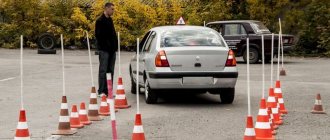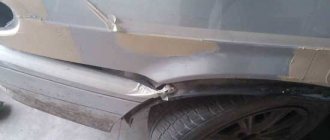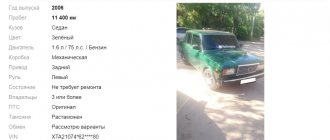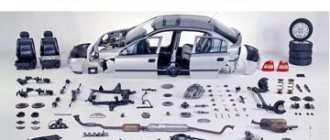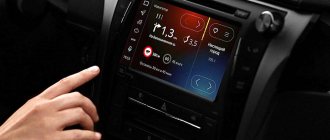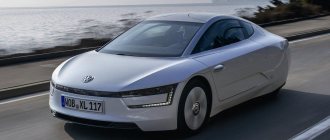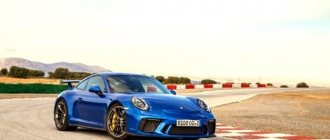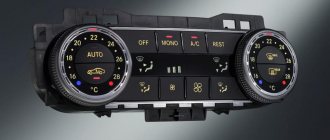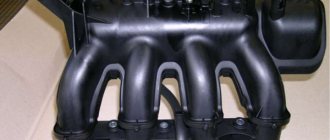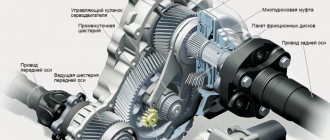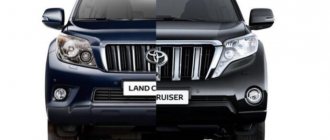To take into account the dimensions of your car on the road, it is not enough to memorize the dimensions of length, width and height in centimeters. You will have to learn to feel the distance from the driver's seat to the bumper and determine by eye how many meters from the body of your car to the next one. In order to learn how to navigate the space while driving and not make deadly mistakes, you should perform several exercises, and then you will feel like a fish in water in a crowded traffic flow.
Why do you need to feel the dimensions of your car?
The car is a source of increased danger. In addition to the high speed of movement, it has certain dimensions, the boundaries of which are difficult for a novice driver to perceive. Therefore, beginners experience problems when driving through narrow sections of the road or parking, causing minor collisions with other road users, surrounding road signs, various structures, parked cars and pedestrians.
Dimensions are the size of the car that is located outside the driver's field of vision. In order not to hit someone else’s car when parking or to competently avoid a pothole on the road, you need to be able to sense this parameter. The whole difficulty lies in the fact that in a driving school the future driver has too few practical lessons to learn to fully feel the dimensions of the car. Therefore, a candidate driver will have to learn this through experience after receiving his license.
It is important to be able to determine the position of the wheels relative to uneven roads. This ability is useful for the driver to drive safely on road surfaces that have potholes or dangerous bumps that can be avoided without reducing speed.
There are several cases where the ability to sense the dimensions of a car can really come in handy:
- rear or front parking;
- entry into the garage;
- driving through a narrow yard among parked cars;
- avoiding potholes on the roads;
The car owner should not only feel every point of the car, but also feel its body, considering it an extension of his body. There is some truth in these words - this is how you can master driving perfectly in a wide variety of situations.
Where would such a skill be useful?
- The first and most important thing is when parking
. In order not to hit fences, curbs and other cars, you must subtly feel that the car has rolled up very close to the obstacle and it’s time to press the brake (if there is a risk of being hit by the bumper) or turn the steering wheel (if there is a risk of hitting some object with the wing). - In traffic jams,
such a skill is also necessary: this is the very situation where you will have to slowly “sneak” behind the car in front, maintaining a constant (and often very small) distance. - When driving in the city,
such a skill will also not be superfluous. If you correctly assess the size of your car, you will not have any problems passing someone on a narrow road, driving past a car parked in the yard, or driving up to a car standing at a traffic light without anyone squeezing in between you without waiting in line. - Countryside and forest areas
also require this skill. Sooner or later, you will probably have to drive along a narrow fire lane, between two closely standing trees, or between a deep pond and some other obstacle. There are no regulated footage here and a sufficient distance for travel is not guaranteed, so you will have to rely only on your intuition.
Types of car dimensions
First of all, you need to understand that the dimensions of the car may have certain characteristics. Depending on the driver’s perception of certain car sizes, the following types of this parameter are distinguished:
- Sensible or visible. The driver can only visually determine the distance to objects or parts of the car, but cannot soberly assess the distance to objects. Various electronic devices can help him with this, for example, a rear view camera or parking radar. Therefore, these dimensions are called perceptible - the driver knows about them, but cannot fully perceive them as truth. For example, rear-view mirrors provide information about the rear dimensions of the car, but help to calculate this accurately. Therefore, parking in reverse can be perceived for a long time as a special exercise that trains the driver’s sense of the dimensions of his car.
- Actual dimensions are the exact dimensions of the vehicle, which were obtained as a result of appropriate measurements or assumptions about the possible position of the wheels on the road surface. Using this information, the driver can perform more complex maneuvers, but it can only be obtained by a detailed study of his car and many other parameters. In addition, you need to constantly monitor electronic devices - parking sensors or rear view cameras.
Another division of car dimensions is the car track and its width. There is a slight difference between these concepts. Rut feeling is the ability to determine the position of the wheels on the road. This skill allows us to drive around holes so that they pass between the wheels. The width allows us to be able to estimate the lateral interval and drive between two parked cars with a minimum interval or its value is too small. The driver must not only be able to identify such dimensions and move forward, but also refuse to drive through such a section in time.
The last type of size assessment is the length of the machine. Useful for parallel parking or reverse parking.
Correct individual preparation of the machine
Every novice driver at the beginning of his “career” experiences convulsive excitement and a desire to literally get out of the car when performing maneuvers (especially parking), to look ahead behind the bumper. There is no escape from this, since excitement goes away only with experience, but there is no point in sending the process of its accumulation into free floating or a long box. When driving in heavy traffic around the city or in a parking lot near a supermarket, where only a few seconds or fractions of them are left to make a decision, convulsively jumping up from the seat and the desire to look beyond the dimensions lead to a loss of control over the situation and a possible accident.
The ease of driving a car depends on the correct ergonomic position in the car, the number of unnecessary body movements is reduced, and the speed and adequacy of decision-making increases. In this case, the driver will be able to assess the situation while sitting calmly in his seat, using movements of his arms, legs, head, or simply his gaze. This is the first thing a beginner needs to do before learning to feel the dimensions of a car.
Proper vehicle fitting should include the following:
- adjusting the driver's seat and steering wheel. This happens taking into account ergonomics and driving safety. You will not feel the urge to move somewhere or get tired quickly if you sit correctly;
- adjusting rear view mirrors. This manipulation is necessary in order to correctly assess the side and rear dimensions of the car located behind the driver. Especially helpful when reversing.
Let's try to briefly outline the basic principles of these actions.
So, the correct fit of the seat and steering wheel consists of the following sequential operations:
- Seat adjustment taking into account clutch, accelerator and brake control. It is achieved by moving the chair forward or backward with the clutch pedal fully depressed and selecting the optimal bending angle of the knees, eliminating the desire to reach forward or limiting the position of the leg under the steering wheel;
- Adjustment of the backrest to eliminate possible body movements when performing leg manipulations.
- Adjusting the steering wheel. The correct position is when there is a palm-thick gap between the rim and the legs, and the outstretched arm touches its upper point with the wrist.
Adjusting the rear view mirrors involves adjusting the interior and side components to get a feel for the rear and side dimensions of the vehicle. In the interior mirror, when positioned correctly, the rear window should be evenly displayed. The side mirrors are adjusted so that they simultaneously show the road and the rear fenders no lower than the door handle. It should be noted that this option will be problematic when parking, since the lower contact zone of the car is not visible. This issue can be resolved by adjusting the mirrors before parking or installing overhead spherical elements for blind spots.
How to learn to feel dimensions?
The car will not always be equipped with parking sensors or a rear view camera. In this case, you will have to learn to feel the dimensions. For this, there are a number of special exercises that develop this useful driving skill. It is necessary to perform them periodically in order to develop the necessary reflexes and habits. It is impossible to master the exercises in one day and at the same time learn to feel the distance perfectly.
Women have the most difficulty driving, as their peripheral vision is poorly developed, which makes it difficult to understand the dimensions of the car. To teach them to see everything around them and identify important points of the body from the outside, a long period of training is necessary. This is the only way to feel the dimensions of the car and choose the right distance when parking.
Feel the wheels
First of all, you need to learn to feel the car's track. Knowing the position of the wheels on the road, you can learn to drive through potholes and even control the car in a tight parking lot, using the information received when maneuvering. You can do this as follows:
- Crumple the plastic bottle and place it on a flat surface.
- When driving the car at different angles, make sure that the front wheels alternately run over the bottle. A plastic crunch indicates that the collision was successful.
Another version of this exercise - a small artificial bump instead of a bottle will also help you learn to see the position of the wheels from inside the car. In the future, this will help, when driving at high speed, to calculate the required distance between the wheels for a hole of maximum size and save the life of the suspension.
Window and mirror landmark
Using the limit lines of mirrors and car windows, you can accurately learn how to park your car so that there are no fines. For example, when parking in front, you need to approach the obstacle until the line of the curb is exactly under the line of the side rear view mirror. In this case, the distance from the curb to the front bumper will be the minimum.
It should also be taken into account that if the curb appears in the mirror when parking backwards, it means that there is very little left to it - literally a few centimeters.
Another good way to control the distance is to place a line of brightly colored tape under the windshield. When parking in front, try to make sure that this line coincides with the line of the curb. It is this mark that will indicate that the required distance to the obstacle has been obtained.
Check-in to the garage
When entering a garage, there is a huge chance of colliding with a wall, especially if the garage space is too short and does not match the diameter of the car. To keep your distance at least for the first time and quickly learn how to do it in any conditions in the future, you can use the following of two techniques.
To control the distance in the garage, you can put a tire without a rim in front and drive up to the wall until the bumper hits the tire. Always remember this distance visually. This skill may help in the future. Another method is suitable for owners of station wagons, hatchbacks, SUVs and even vans. In the garage, a tennis ball is suspended from the ceiling. The driver drives backwards until he touches the ball. Remember this distance - it will be useful in the future.
It should be taken into account that the distance from objects and buildings in the rear should be such that it allows the driver to fully open the rear trunk lid. Especially when it comes to commercial vehicles.
Tower of boxes
Another good way is to help you learn to feel the dimensions when turning the car and avoid touching the corner of the bumper when turning, turning, moving backwards, etc. You need to do the following:
- Build a small tower out of cardboard boxes by stacking 4-5 boxes on top of each other. The height of the tower should be such that it can be seen through all windows of the car while driving.
- Back up and turn in such a way that each time you pass as close as possible to the boxes. The moment of contact will indicate that the interval or distance to the obstacle is already too small. This will be that very moment or distance, the limits of which cannot be lowered.
Simple exercise: hitting
With good practice, you can repeat the results of a simple “hitting” exercise without errors. To quickly and firmly understand how to feel the dimensions of a car, an empty plastic bottle is placed on the platform, which you need to run over with your front wheels one by one. We need to ensure that a seemingly simple exercise can be done without effort.
Then, to consolidate the skill of sensing dimensions, the exercise needs to be complicated by increasing the speed to 60 km/h. The third stage is hitting a bottle with a synchronized turn.
The high complexity of the maneuver helps to get good results and begin to feel the dimensions of the car. In this phase, you can do without a bottle, and use any object that is easily compressed, while making a loud sound. It should not fly out from under the wheels.
Special technical means
Not only your own intuition, flair and geometry, but also special gadgets can help you learn to control the dimensions of a car. For example, one of the best tools that can estimate the lateral distances around the perimeter of a car are all-round cameras. Such devices help track the distance to almost all objects surrounding the car in the parking lot and help avoid accidental contact with other cars. The only difficulty is getting used to the monitor images, when you need to remember which camera is responsible for which part of the car.
Another way is to use blind spot mirrors. But when parking, they will help us not in identifying cars from the side, but when parking backwards. If you point them down, they will point towards the rear wheels. The theory indicates that it is easier to see the curb next to the wheels. Therefore, you need to start looking in this direction.
Don’t forget about the most popular ones – parking sensors, popularly called “parking sensors” and a rear view camera. At least one of these gadgets must be installed on every car sold. When purchasing parking sensors or cameras, you should be careful with Chinese products. If a Chinese camera is much easier to replace if it breaks down, then with parking sensors everything is much more complicated, especially if they are painted in body color or have a unique mount. Damage to such a sensor leads to replacement of the bumper or expensive restoration of the sensor, which most likely will not be available for sale.
What do driving schools, Internet sites and experienced drivers advise?
- The most banal, but also the most effective, advice is practice. Practice as much as possible, first in the driving school where you are studying, then on your own, at least in an “open field,” setting for yourself some conditional “obstacles” (those that cannot damage the car). Every successful and every failed attempt to park perfectly in a narrow space brings you closer to your cherished skill. For this purpose, you can make unique beacons - thin, light poles fixed in sand-filled bottles; When parking, such poles should be lightly touched by the bumper or fender, but so that they do not fall. If the beacon swings but does not fall, the task is considered perfectly completed.
- At first, you can drive with barely noticeable stickers on the windows - they will show you the approximate line along which the front wheels roll. To glue them correctly, find a spacious area and place the car on it so that the wheels “look” forward. Now draw straight lines under them in the direction of travel (while drawing, imagine that the car should roll exactly along these lines); then sit in the driver's seat and imagine the continuation of these lines on the windshield. Stick small stickers there: they will help you figure out where the front wheels will go now.
What mistakes do newbies make?
The main mistake of beginners is that they get behind the wheel completely unprepared. This means that without any sense of size, they get behind the wheel and hit various obstacles, other cars, etc. with their car. Minor accidents like this do not happen without consequences. Before driving into narrow spaces, you need to get used to the dimensions of the car and use our advice. This is the only way to get out of your first independent trip without damage.
The exact opposite problem is overconfidence, which causes young drivers to commit rash acts while driving, putting themselves and other road users at risk. In the process of such antics, there is a huge chance of not fitting into a turn or between other cars and becoming the culprit of a terrible accident.
It should also be remembered that dimensions vary depending on the machine used. For example, Renault Logan is considered quite compact and has ample parking options. At the same time, the Kia Rio is also in demand among car owners, but what causes the most indignation is its visibility and small turning radius. And all because of the large dimensions, which are much smaller in Renault Logan. Therefore, a beginner must quickly learn and feel the dimensions of a new car.
Tags
For better vehicle sensitivity, make marks on the front glass. If you use a large meter or ruler and lean it against the hood, namely where the center of the drive wheel is located, then lean the other end against the front glass. In the place that will be located on the axis of the rear wheel, a mark must be applied with a pencil or a drop of paint. And repeat the same steps with the front tire. Thus, the marks made will help in the sensitivity of dimensions and in any situation in choosing the correct movement, such as parking, entering a narrow garage and other similar places. On a bad and uneven road, the ability to feel the dimensions will also be beneficial.
For a beginner and not only, the dimensions can be felt using the vehicle body. For a novice driver, it is better to install a deflector for visibility and sensitivity of dimensions. Also, many cars are now being produced with voluminous headlights, the so-called bulges. Such convexities serve to more effectively understand the dimensions. And the mirrors will become markers on the sides, with the help of them it is very easy to navigate. It will be difficult to learn to perceive rear dimensions. Owners of crossovers and hatchbacks need to pay attention to the windshield wiper to get their bearings; it will be worse for owners of sedans.
Practicing the sense of wheel line
To learn to feel the line of the wheels you need to work hard. To do this, we again use improvised means, this could be a plastic bottle or a small cardboard box. We place the prepared object in front of the car and alternately run over it first with the left and then with the right wheel. After this exercise, place these objects at a distance of a meter from each other and drive in such a way that they are between the wheels.
After practicing these skills, use the same algorithm of actions only when driving in reverse. This is a rather difficult exercise, but if done systematically, you will learn to estimate the dimensions of the car in a short time.
Tips for novice motorists
One of the main mistakes beginners make is trying to see what is in front of the car's bumper. This is fundamentally wrong, and this desire can lead to unexpected consequences. The driver must look only in front of him while driving.
Correctly setting the mirrors will help you park in reverse without any problems. They need to be adjusted so that the external mirrors reflect the wheels of the rear axle. Exterior mirrors monitor the sides of the vehicle. It is important to learn how to use them.
When driving on a highway outside the city, sometimes it happens that you inadvertently cut off a car driving from the side when changing lanes. To prevent this from happening, start your maneuver only when you can see the entirety of the adjacent vehicle in the side mirror.
Action plan
The first rule of an experienced driver: “If you have doubts due to lack of visibility or due to poor visibility, poor condition, then you need to stop and not be lazy to go outside and look.” Intuitively, while driving, the desire often comes to wait a few seconds and check what is overboard.
This rule must always be followed during any type of maneuver. This way, the highest level of aerobatics is achieved, the safety of your car and the health of passengers. Even when driving through a green light right away, you should once again make sure that traffic is safe by turning your head left and right. So when parking, you should constantly monitor three viewpoints at once. At any second, a restless baby could sit under your bumper in the yard.
The ability to sense the dimensions of your car is the key to safe and fast driving. When the situation on the road is critical, there is no time to think and count; you can only turn this situation in any direction. Sometimes on the road it’s more useful to stay in the lane and slip through the gap between cars, and sometimes you need to cling to the bump stop on the highway and pass the crazy oncoming traffic, leaving the car intact.
